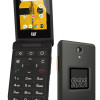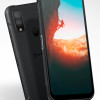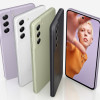Report from Redmond
There are some particularly cool things I liked about Phone Edition and Smartphone. Most of these apply to both platforms, since they are so similar internally.
Performance
As I touched on earlier, the performance of the ARM architecture is impressive. Pocket PC is slowly moving toward the new Intel xScale architecture, (and Intel just announced new xScale processors for cell phones,) but the ARM architecture holds its own quite well against xScale. (In fact, xScale performance has been downright disappointing so far, but I digress...)
It's not much use trying to explain the performance in words, so here are a couple of video clips that I think demonstrate it well:

QuickTime format

QuickTime format
Of course, games are always a good benchmark of performance, particularly for graphics. These are two games by Digital Concepts that really showcase the power of the ARM architecture and the Pocket PC / Smartphone platforms. While it may seem to only show the graphics capability, the Bust'em game actually employs some intense particle physics, and the Motocross game uses voxels for 3D rendering, so there is some significant non-graphics processing going on there as well. These videos are from a Pocket PC Phone Edition, but I have seen these same games demonstrated on a Smartphone, and the graphics are equally impressive on that platform.
As you can see in both videos, I'm using the stylus for control, but you can also use the buttons. Also as you can see, Motocross Stunt Racer can be configured to run in landscape mode. Since the HTC Phone Edition device has buttons at both ends, it is actually excellent for two-handed gaming.
Multi-tasking
Another really cool feature of both operating systems is multi-tasking. In particular, when you "close" an application, it actually remains open in the background. While this makes it easy to fill up your memory pretty quickly, it also lets you do several things at once. For example, you could sync your contacts over-the-air with an Exchange server, while having several IM sessions going, while playing a game in the foreground, all while listening to MP3s in the background! Of course you'd probably only ever do that to impress your friends, but isn't that half the reason you buy a phone like this anyway?
Developer Community
It goes without saying that there are an awful lot of developers out there who are familiar with programming for the Windows platform. Those developers can use all the same tools and languages to program for Microsoft's mobile operating systems, as well. In fact, there is already a considerable community of Pocket PC developers.
And as I mentioned earlier, Smartphone is very similar to Pocket PC from a developer's perspective - it takes less than a day to port most applications from Pocket PC to Smartphone. Therefore, there is the potential for a plethora of applications for that platform as well (if the carriers allow it, of course.) That is a huge strength of Smartphone - it may be the new kid on the block, but it will come to the table backed by an army of developers from day one.
And speaking of moving from Pocket PC to Smartphone, it's worth mentioning that Internet Explorer for Smartphone will automatically re-size and display web pages designed for Pocket PC. So web developers can easily create one page that will display well on both platforms, despite the different screen resolutions.
.NET Compact Framework
What is .NET? Well, it's basically about software that connects well with other software. .NET Compact Framework (.NET CF) is that concept, applied to Pocket PC; it's a framework for developers to quickly and easily write web-services-enabled applications. (If you're still reading this, congratulations! Most people would have tuned out a few buzzwords ago.) As actual software, .NET CF is a small (1.5MB) piece of code that resides on the Pocket PC. The end-user never sees it, but it's a very powerful tool for applications.
An example scenario might be an online auction tracker. You would have a small application installed on you Pocket PC for tracking online auctions. It would use .NET CF to talk to a web service provided by the online auction site. The application could display periodic auction updates. Because it wouldn't use the browser or have to load whole web pages, it would be faster and use much less bandwidth, saving you money on your wireless bill.
Flash
One thing that I haven't seen much talk about, but I think is very exciting, is Flash Player for Pocket PC. However many current and future Pocket PC developers there might be, there is a still a certain level of programming skill one needs to create compelling games and applications. Flash opens up the platform to a much wider community of potential developers.
And the Pocket PC Flash player even supports HTTP functions, so Flash applications can be Internet-enabled. This makes it really easy to write games you can play against other people over the Internet, and even applications with a web-services-like back-end. Just as with .NET CF and web services, converting a mobile web site to Flash would allow for a much richer interface, using far less bandwidth.
And, as always with Flash, the files are very small, and it can scale to nearly any size. It's pretty easy to create one small Flash file that will run equally well on desktop PCs, Pocket PCs, and Smartphones.
Email Attachments
Email with attachments is an increasingly common feature on high-end smart-phones in general. But again, Windows Powered Smartphone is designed to bring that kind of feature to a much smaller size and lower price point than any phone before. And the use of standard file formats in the OS makes it very powerful.
For example, I could record a voice note on my Pocket PC, and send it to your Smartphone in an email (this is very easy with Pocket Outlook). Then you could make it your ringtone. You could then capture a screenshot of a game, and send it to me. I could then save that and make it my wallpaper. I could then send a Flash game to you, and you could play it.
In fact, I think the ability to easily email Flash files between Smartphones and Pocket PCs is awesome. Most people have received Flash files, or links to Flash files, in emails that get passed around the Internet like wildfire. Bringing that kind of functionality to phones, for games or even just funny animations, goes way beyond MMS. And because it's relatively easy to "roll your own" Flash files, and they can be exchanged via e-mail attachments, which carriers don't control, it opens the door for all sorts of compelling, free content - by the users, for the users.


 Samsung Refreshes Galaxy S Series with S Pen, New Cameras
Samsung Refreshes Galaxy S Series with S Pen, New Cameras
 CAT Puts Android With Play Store in a Compact Flip Design
CAT Puts Android With Play Store in a Compact Flip Design
 Samsung Lets You Design Your Own Galaxy Z Flip3
Samsung Lets You Design Your Own Galaxy Z Flip3
 Kyocera Intros Slim, Rugged 5G Phone for Consumers
Kyocera Intros Slim, Rugged 5G Phone for Consumers
 Samsung Revives S21 Fan Edition
Samsung Revives S21 Fan Edition

